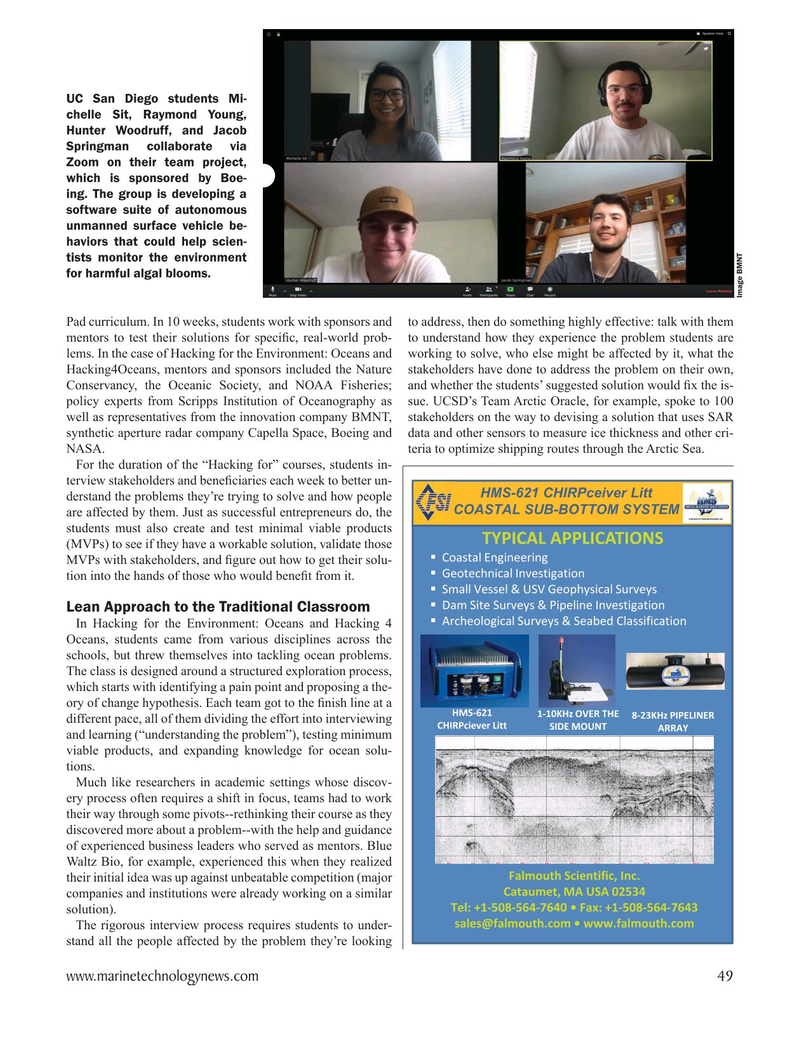
Page 49: of Marine Technology Magazine (September 2020)
Read this page in Pdf, Flash or Html5 edition of September 2020 Marine Technology Magazine
UC San Diego students Mi- chelle Sit, Raymond Young,
Hunter Woodruff, and Jacob
Springman collaborate via
Zoom on their team project, which is sponsored by Boe- ing. The group is developing a software suite of autonomous unmanned surface vehicle be- haviors that could help scien- tists monitor the environment for harmful algal blooms.
Image BMNT
Pad curriculum. In 10 weeks, students work with sponsors and to address, then do something highly effective: talk with them mentors to test their solutions for speci? c, real-world prob- to understand how they experience the problem students are lems. In the case of Hacking for the Environment: Oceans and working to solve, who else might be affected by it, what the
Hacking4Oceans, mentors and sponsors included the Nature stakeholders have done to address the problem on their own,
Conservancy, the Oceanic Society, and NOAA Fisheries; and whether the students’ suggested solution would ? x the is- policy experts from Scripps Institution of Oceanography as sue. UCSD’s Team Arctic Oracle, for example, spoke to 100 well as representatives from the innovation company BMNT, stakeholders on the way to devising a solution that uses SAR synthetic aperture radar company Capella Space, Boeing and data and other sensors to measure ice thickness and other cri-
NASA. teria to optimize shipping routes through the Arctic Sea.
For the duration of the “Hacking for” courses, students in- terview stakeholders and bene? ciaries each week to better un-
HMS-621CHIRPceiverLitt derstand the problems they’re trying to solve and how people
COASTAL SUB-BOTTOM SYSTEM are affected by them. Just as successful entrepreneurs do, the students must also create and test minimal viable products
TYPICAL APPLICATIONS (MVPs) to see if they have a workable solution, validate those ?CoastalEngineering
MVPs with stakeholders, and ? gure out how to get their solu- ?GeotechnicalInvestigation tion into the hands of those who would bene? t from it.
?SmallVessel&USVGeophysicalSurveys ?DamSiteSurveys&PipelineInvestigation
Lean Approach to the Traditional Classroom ?ArcheologicalSurveys&SeabedClassification
In Hacking for the Environment: Oceans and Hacking 4
Oceans, students came from various disciplines across the schools, but threw themselves into tackling ocean problems.
The class is designed around a structured exploration process, which starts with identifying a pain point and proposing a the- ory of change hypothesis. Each team got to the ? nish line at a
HMS?621 1?10KHzOVERTHE 8?23KHzPIPELINER different pace, all of them dividing the effort into interviewing
CHIRPcieverLitt SIDEMOUNT
ARRAY and learning (“understanding the problem”), testing minimum viable products, and expanding knowledge for ocean solu- tions.
Much like researchers in academic settings whose discov- ery process often requires a shift in focus, teams had to work their way through some pivots--rethinking their course as they discovered more about a problem--with the help and guidance of experienced business leaders who served as mentors. Blue
Waltz Bio, for example, experienced this when they realized
FalmouthScientific,Inc.
their initial idea was up against unbeatable competition (major
Cataumet,MAUSA02534 companies and institutions were already working on a similar
Tel:+1?508?564?7640?Fax:+1?508?564?7643 solution).
[email protected]?www.falmouth.com
The rigorous interview process requires students to under- stand all the people affected by the problem they’re looking www.marinetechnologynews.com 49
MTR #7 (34-49).indd 49 9/11/2020 11:35:48 AM

 48
48

 50
50
